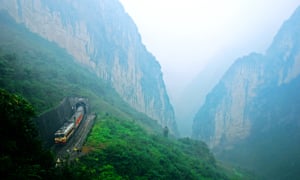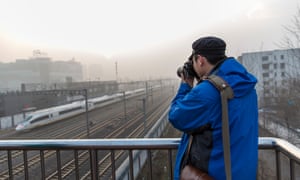It has been 10 years since China’s self-styled “train hunter” set off on a 300,000km quest to document the greatest railway lines on Earth.
Armed with his trusty Nikon camera, Wang Wei has hiked up to the frosty Tibetan plateau and across the Gobi desert; he has journeyed to a tropical island in the South China Sea and to China’s remote border with Pakistan – all to satisfy his inexplicable urge to photograph trains.
“I never get tired. You don’t get tired if you are doing something you feel truly passionate about,” says Wang, who at 24 has already built a personal archive of hundreds of thousands of photographs of trains.
China’s No 1 trainspotter, who grew up just next to Beijing’s Xizhimen station and still lives with his parents, believes he was born with a fascination for ferroequinology.

His great-grandfather was a train driver who once transported Wu Peifu, a warlord whose exploits in early 20th-century China earned him a place on the cover of Time magazine alongside the headline: “Biggest man in China”.
“I think there might be a love for trains in my blood,” confesses Wang, whose bedroom walls are covered with his photographs of trains from around China.
His train hunting mission – which he officially launched in 2005 – has coincided with one of the most spectacular bursts of railway construction in history; an immense engineering project that some compare to the 19th-century railway boom that helped make the US the world’s leading economy.
In 2006, the year after Wang’s expedition began, China opened the highest railway line on Earth, finally fulfilling Mao Zedong’s dream of integrating Tibet with central and eastern China.

The following year, China upped the ante again, kicking off a multibillion dollar high-speed rail revolution designed to demonstrate the Communist party’s scientific – and political – might.
Since that pre-Olympic push began, China has built the world’s longest and fastest high-speed rail routes, using sleek white bullet trains to slash the distances between mega-cities including Beijing, Shanghai and Guangzhou.
In just over seven years, about 11,800 miles (19,000km) of high-speed track – about 55% of the global total – has been laid. “What the world did in half-a-century, we have done in 10 years,” said Zhao Jian, a transport expert from Jiaotong University in Beijing.
China’s high-speed lines were initially concentrated along the wealthy eastern coast but increasingly the revolution is sprinting westwards into the deserts and mountains that surround the old Silk Road, at speeds of more than 215 miles per hour (350kph).
Beijing’s railways are also going global with countries including the US, Thailand, Indonesia and the UK poised to build high-speed rail projects with differing levels of Chinese involvement.

There were even reports earlier this year that China was considering expanding its rail empire by punching a tunnel under Mount Everest.
The furious pace of the expansion has raised red flags, including misgivings over safety in the wake of a deadly 2011 high-speed rail crash near the city of Wenzhou. The disaster, which claimed 40 lives, exposed a web of corruption at the heart of the country’s railways ministry, which was officially disbanded in 2013.

Zhao, a long-term critic of China’s high-speed push, said there were also doubts over the financial viability of many projects. Building such connections between major cities such as Beijing or Shanghai made sense but doing so in China’s less densely populated interior was financial madness. “It is like building a 160-floor hotel where only 27 floors make a profit and the rest suffer serious losses,” he said.
Wang, who has photographed seven of China’s eight key high-speed “arteries”, describes high-speed rail as a “great invention” that had profoundly changed the lives of millions of Chinese citizens.
“In the past, if I wanted to go to Shanghai that would mean spending a whole night on a train unless I took the plane. Now, it’s only a couple hours by train. It has certainly made it easier for me to travel from A to B,” he says.
But Wang admits his soft-spot is for China’s old-fashioned fleet of trains, of which some Mao-era models are facing extinction.
“It’s quite sad to see the old stations and rail lines being demolished. I’m quite a nostalgic person and I like old things,” he says. “But it’s inevitable as time goes by. The only thing I can do is to document the changes in an artistic way.”
Wang’s travels have given him a first-class seat to witness his fast changing homeland.
By plane, car and rail he has journeyed to Kashgar, an ancient Silk Road trading hub in China’s far west, Mohe, at the country’s northernmost tip, and to the balmy island of Hainan, which recently opened the world’s only high-speed rail “loop line”.
“There are people who believe that travelling abroad is superior to exploring their own country,” says the train buff whose travels have made him a proud patriot determined to use his work to show off China’s natural beauty as well as its trains.
Train hunting is not for the lighthearted. During a trip to a remote village in the south-western province of Guizhou, Wang and a friend were forced to cram into a rickety single bed beside a pigsty.
While trekking across the Gobi desert earlier this year he accidentally skewered his foot with a large thorn and ended up in an Inner Mongolian emergency room. “I looked down and realised there was a lot of blood on the floor,” he recalls. “It didn’t hurt much at first, but I almost fainted when the nurses in hospital tried to clean the wound.”

Wang’s most treacherous mission was during a trip to the mountain-studded province of Qinghai where he spent a week hiking at night to secure the best shot of his target train. “The oxygen levels there are very low because it is on the [Tibetan] plateau and the altitude is so high,” he says. “I felt a terrible headache when I was climbing.”
Ten years after China’s biggest train enthusiast began his wanderings, the railway boom shows no sign of abating. State media announced last month that £288.6bn would be pumped into 14,000 miles of track from now and 2020.
For Wang that means the hunt goes on. “I will never stop,” he says. “This is a permanent project.”
Additional reporting by Luna Lin and Christy Yao


